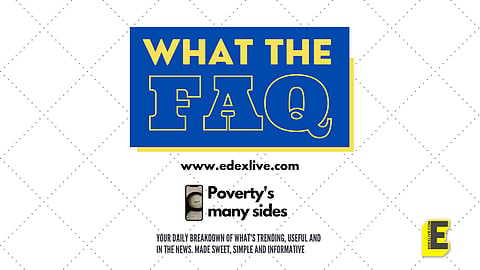

Poverty prompts one to think in terms of monetary means only, how much money someone has or doesn't have. But multidimensional poverty is a much broader term that tries to take into account several other indicators that helps one get a better sense of poverty. Here's where National Multidimensional Poverty Index comes in. This baseline report was released by NITI Aayog.
So what is National Multidimensional Poverty Index, which is based on National Family Health Survey-4 (2015-16), all about and how does it help us understand about India's poverty? Here are the answers.
First of all, what is multidimensional poverty?
Multidimensional poverty capture multiple and simultaneous deprivations faced by households. These include lack of education, disempowerment, inadequate living standards, poor health, poor quality of work, the threat of violence and beyond.
What does India aim to do with the Multidimensional Poverty Index (MPI)?
The aim is to understand and benchmark poverty reduction to help with the country's performance and attempt to reach out to those furthest behind by looking at reform areas and coming up with reform actions. It also provides insights on subnational and district levels.
What is the method to measure multidimensional poverty?
Alkire-Foster (AF) methodology is used which is a general framework for measuring multidimensional poverty. A dual cut-off method is used to identify people as poor or not poor. The first order cut-off within each component indicator is applied to check which person is 'deprived' under a particular indicator. Then, the information across all the indicators is aggregated so that for each individual, a deprivation score can be arrived at. Post this, the second order cut-off is applied to check individuals who are multidimensionally poor.
READ ALSO : What the FAQ: China is now the richest country in the world. But what exactly does that mean?
How is MPI computed?
The process has two broad categories: identification and aggregation.
First comes identifying indicators and grouping them under one dimension. For example, years of schooling and school attendance would fall under education. Determining deprivation cut-offs for each indicator and then applying it to each individual to determine which indicator they are deprived under comes next. Weights are selected that can be applied to each indicator so that the sum of the weights of all indicators is 1. When each individual's weighted sum of deprivations is calculated, the sum arrived at is known as the deprivation score. The proportion of weighted deprivations that each individual needs to experience to be identified as multidimensionally poor is the second order cut-off, which is 33.33 per cent for India, which is also used in the global MPI measure.
When it comes to aggregation, once the proportion of individuals identified as multidimensionally poor is determined, this figure is known as headcount ratio (H) of the MPI or the incidence of poverty, this gives us a sense of 'how many are poor. The average share of weighted indicators in which each multidimensionally poor person is deprived, that is adding deprivation scores of the poor and dividing it by the total number of poor individuals, is determined. This is the intensity of poverty (A) which gives us a sense of how poor are the poor. This is also known as the breadth of poverty. Next comes computing the MPI score (M0) as the product of the partial indices of Headcount Ratio and Intensity.
What are the indicators India used?
The three dimensions were education, the standard of living and health (each given 1/3 weights). Indicators under health are nutrition (1/6), antenatal care (1/2) and child and adolescent mortality (1/2). Under education, the indicators are years of schooling and attendance (1/6 each). While under the standard of living there are seven indicators cooking fuel, sanitation, drinking water, electricity, housing assets and bank accounts (1/21 each).
What are some important analyses brought up by the report?
- Bihar (51.91 per cent), Jharkhand (42.16 per cent) and Uttar Pradesh (37.79) have emerged as the poorest states in India
- Kerala (0.71 per cent), Goa (3.76 per cent), Sikkim (3.82 per cent) and Tamil Nadu (4.89 per cent) have the lowest poverty rates
- When it comes to union territories, 1.72% of Puducherry's population is poor while in Lakshadweep, the percentage stands at 1.82%. In Andaman & Nicobar Islands it's 4.30% and it's 4.79% for Delhi.
